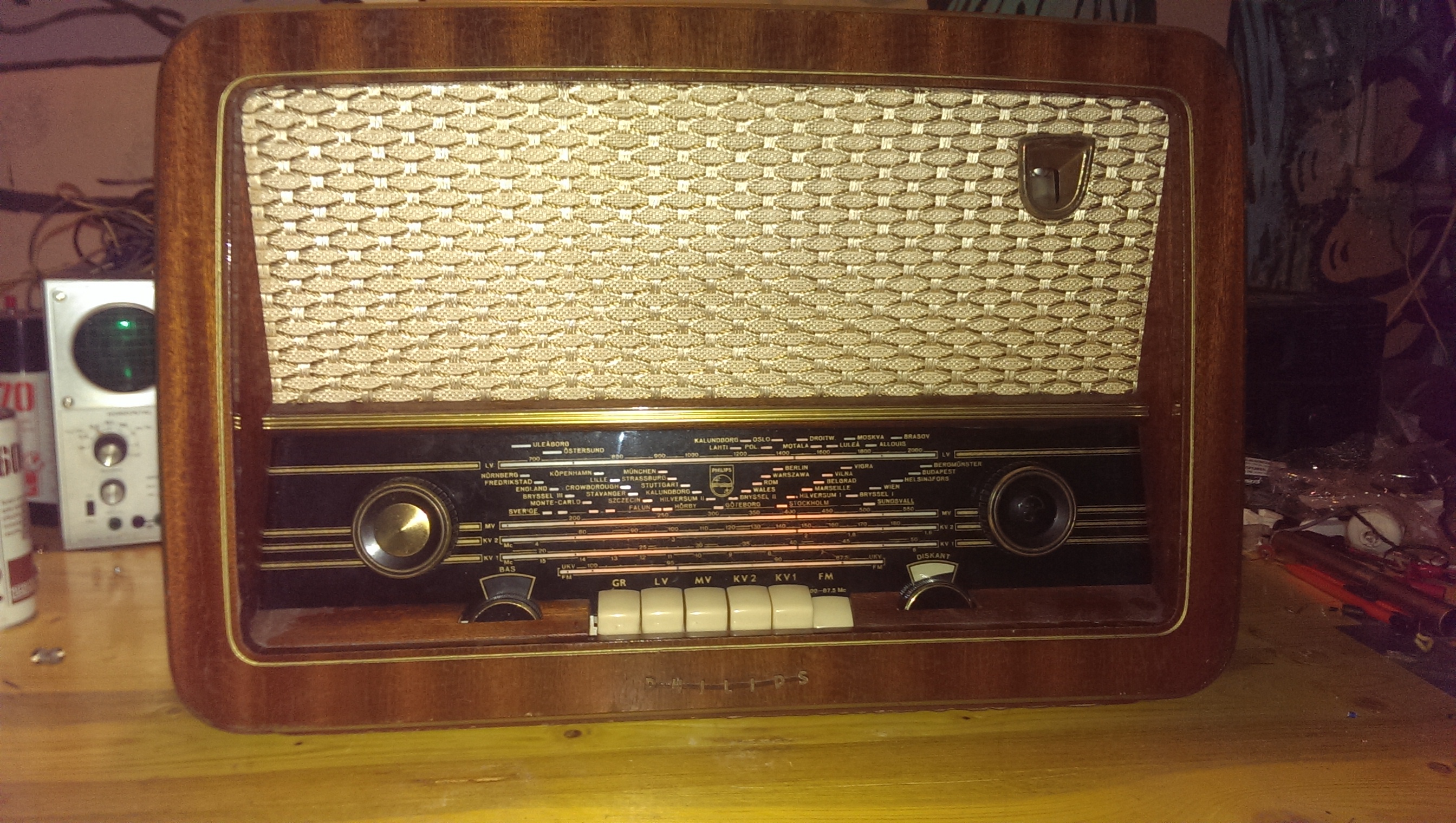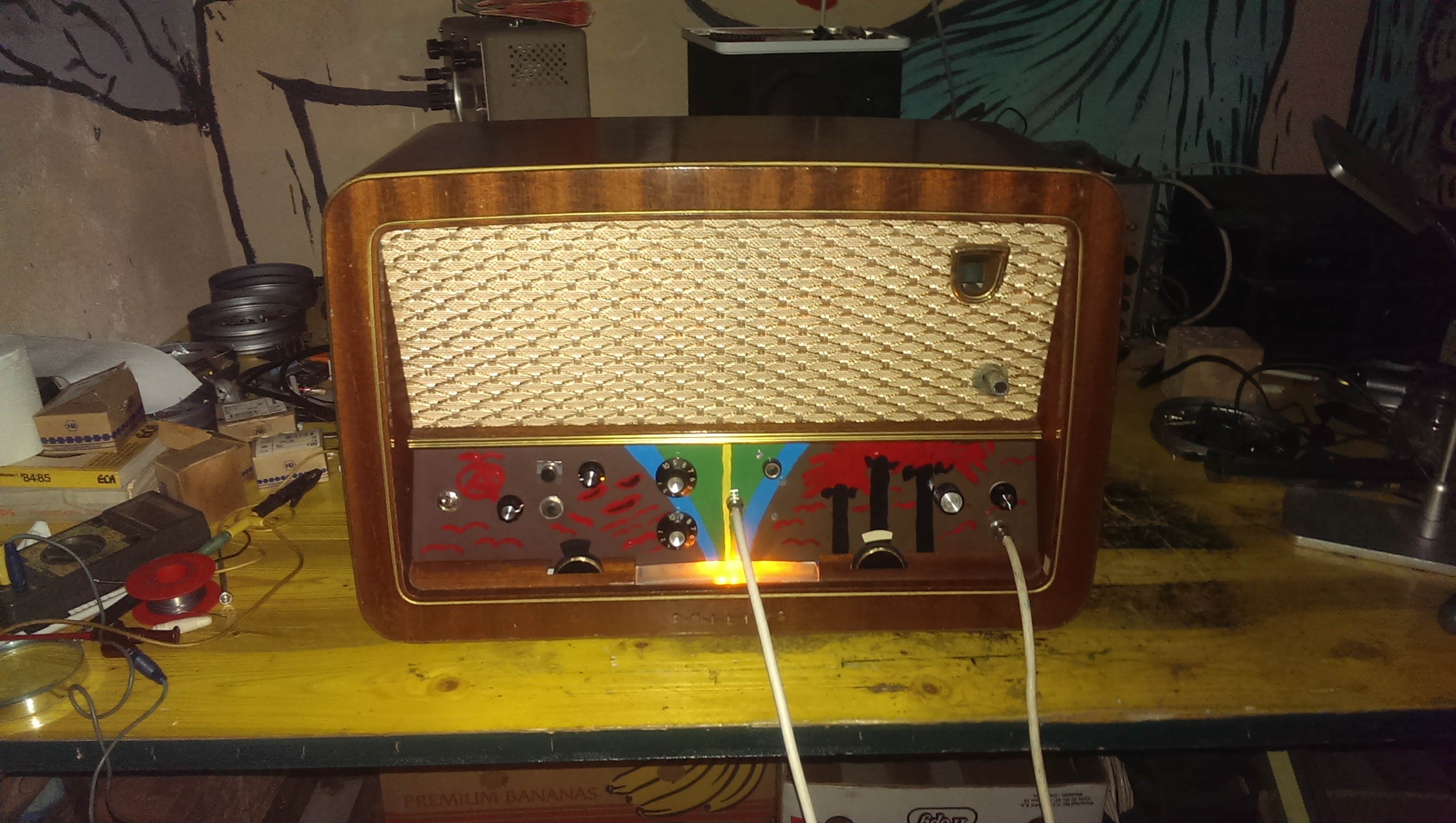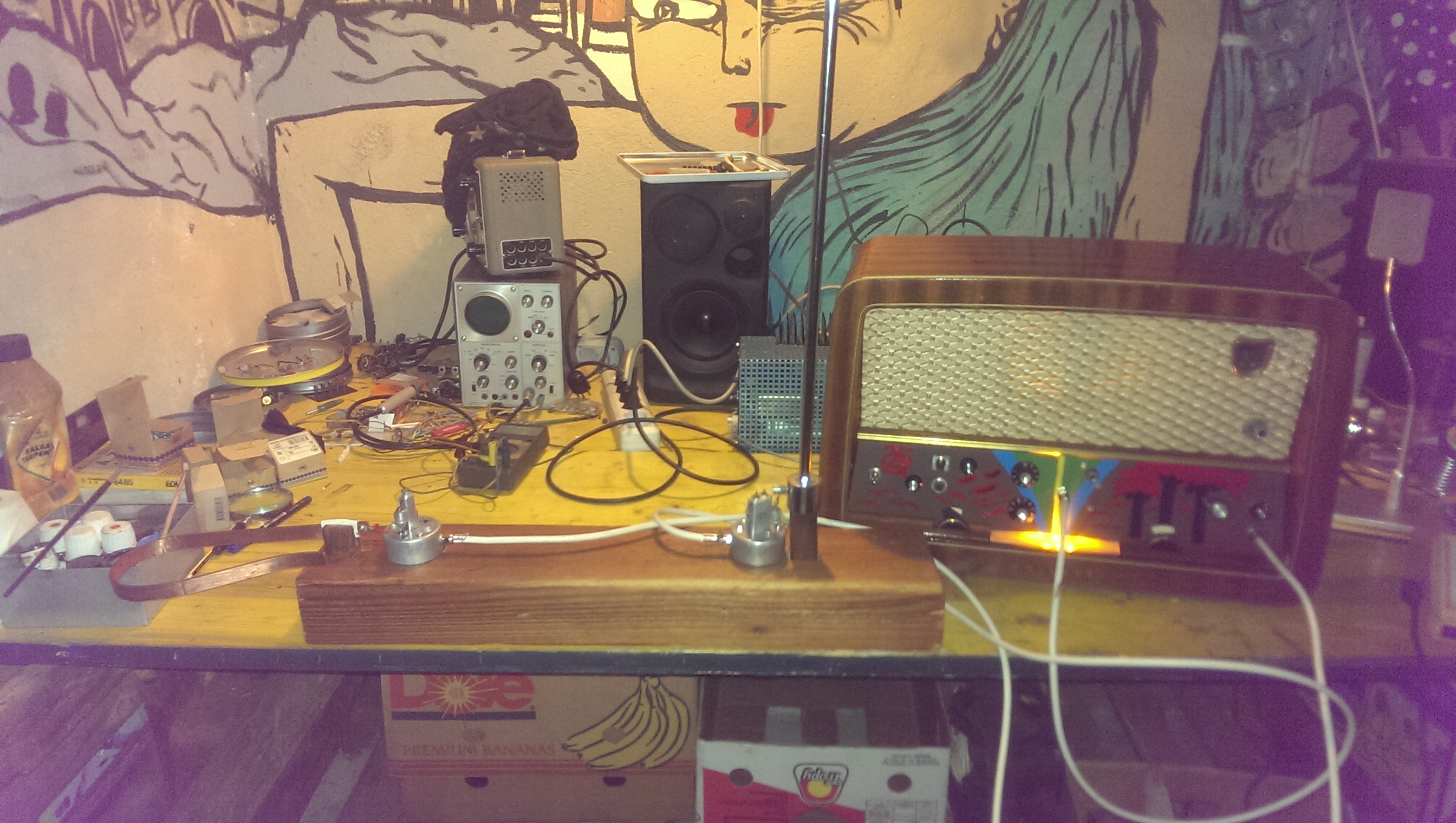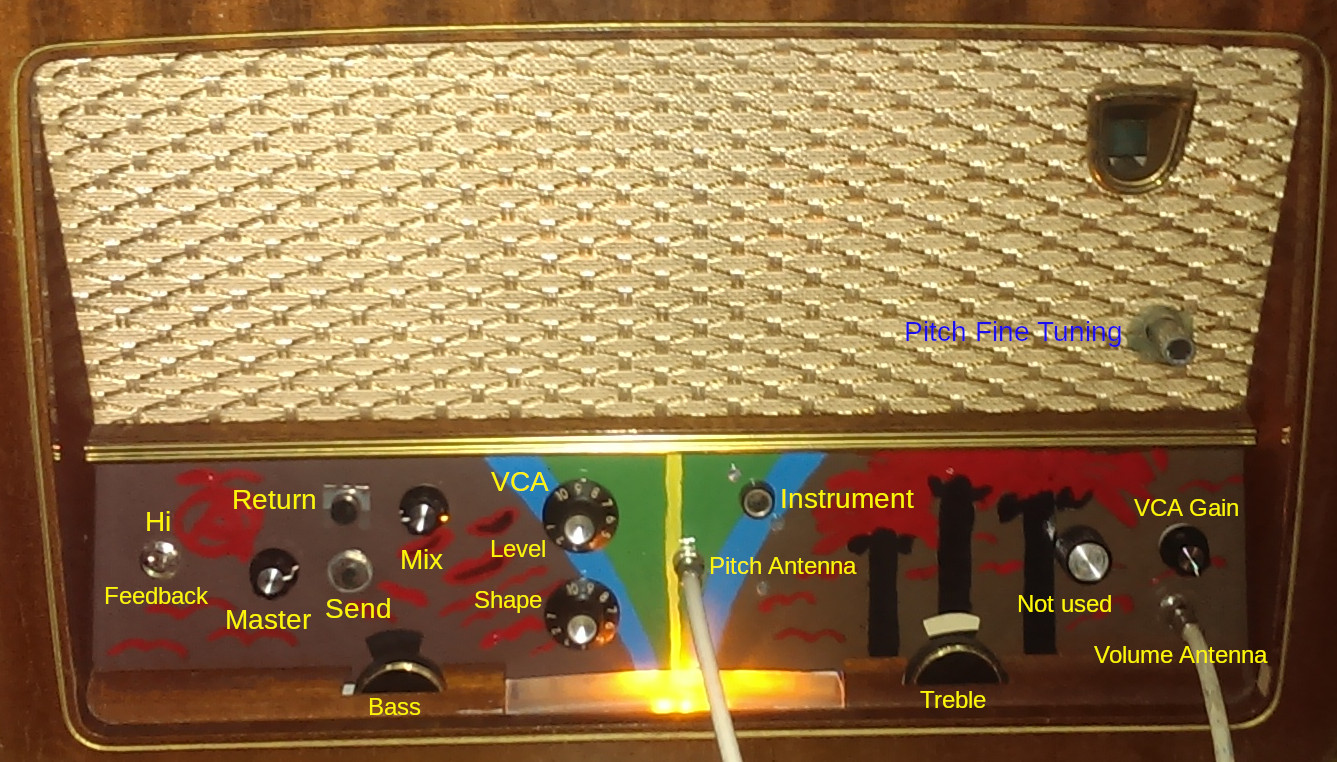I made a theremin from an old philips vacuum tubes radio and other recuperated parts. I called that instrument the Black Star because a buddy have a very funny border collie named Star.
This was really a challenge to make it because that instrument mix audio and high frequency. For those that doesn't know how a theremin work, you have a box with 2 antennas, one to control the volume, the second one to control the pitch.
The pitch circuit is the easy part. You have 2 high frequency oscillators, a fixed one and a variable one. Their signals go into a mixer and its output f1-f2 is the audio.
That audio go though a VCA. The volume antenna control a third high frequency oscillator, a variable one which control the gain of the VCA.
It is also an audio amp and a speaker.
The original radio:

The Black Star theremin:

An external DC heater power supply with slow startup (the theremin work fine without it):

The 2 antennas. It is the only theremin I know with external antennas. For that to work well, the whole LC tanks of the oscillators are with the antennas:

The inside:

The whole instrument:

The commands:

Instrument is to plug in an instrument. It can work as guitar amplifier and I get terrific sounds with it. The output transformer of the original radio is of outstanding quality, which make possible to get better sounds than with my Fender Champ.
Send and Return are for use with external effect like octave divider, phaser, distortion and so on. Especially when used as guitar amplifier, it have enough gain, which imply no distortion is needed even to play punk or metal music.
Hi/Feedback disable/enable feedback on the output stage. All other preamp like stages have no feedback.
Mix is for mixing the audio with the signal coming in from Return.
VCA Level, Shape and Gain control the VCA and the Shape of the signal. VCA Gain also influence the range of the volume antenna. This give many possibilities of controlling the sound, ranging from the "classical" theremin sound with low distortion to very modern sounds with high distortion levels.
Practically, the major difficulties was the selection of the condensators for the oscillators, in some cases only mica or air condensators was working good enough. And the ground strategy. High frequencies find the shortest way into the metallic chassis when audio frequencies must have a separated ground circuit.
EDIT: I almost forgot it. I made a web site with the schematic, some docs, pictures and sound samples: GitHub - domichel/black_star_theremin: Documentation of a vacuum tubes theremin hardware
This was really a challenge to make it because that instrument mix audio and high frequency. For those that doesn't know how a theremin work, you have a box with 2 antennas, one to control the volume, the second one to control the pitch.
The pitch circuit is the easy part. You have 2 high frequency oscillators, a fixed one and a variable one. Their signals go into a mixer and its output f1-f2 is the audio.
That audio go though a VCA. The volume antenna control a third high frequency oscillator, a variable one which control the gain of the VCA.
It is also an audio amp and a speaker.
The original radio:

The Black Star theremin:

An external DC heater power supply with slow startup (the theremin work fine without it):

The 2 antennas. It is the only theremin I know with external antennas. For that to work well, the whole LC tanks of the oscillators are with the antennas:

The inside:

The whole instrument:

The commands:

Instrument is to plug in an instrument. It can work as guitar amplifier and I get terrific sounds with it. The output transformer of the original radio is of outstanding quality, which make possible to get better sounds than with my Fender Champ.
Send and Return are for use with external effect like octave divider, phaser, distortion and so on. Especially when used as guitar amplifier, it have enough gain, which imply no distortion is needed even to play punk or metal music.
Hi/Feedback disable/enable feedback on the output stage. All other preamp like stages have no feedback.
Mix is for mixing the audio with the signal coming in from Return.
VCA Level, Shape and Gain control the VCA and the Shape of the signal. VCA Gain also influence the range of the volume antenna. This give many possibilities of controlling the sound, ranging from the "classical" theremin sound with low distortion to very modern sounds with high distortion levels.
Practically, the major difficulties was the selection of the condensators for the oscillators, in some cases only mica or air condensators was working good enough. And the ground strategy. High frequencies find the shortest way into the metallic chassis when audio frequencies must have a separated ground circuit.
EDIT: I almost forgot it. I made a web site with the schematic, some docs, pictures and sound samples: GitHub - domichel/black_star_theremin: Documentation of a vacuum tubes theremin hardware
Last edited:
Very good idea for upcycling an irreparably defective tube radio - and only for this one!
I would have mounted the antennas directly to the case, though, thus avoiding these long cables.
Best regards!
I would have mounted the antennas directly to the case, though, thus avoiding these long cables.
Best regards!
To have separated antennas is a feature: I just wanted to be sure the case of the radio is not in my way when playing. It you look at the existing theremins, the transistor ones are small enough for the placement of the antennas to not be a problem. The vintage ones are very big devices and the antennas are always placed at or near the top of these devices, when in an antique radio like this one, the electronic is at the bottom of the case. Also, the vintage theremin are using very big air coils, which facilitate the placement of the antennas at the top, when this radio, one of the last ones made by philips with tubes, already use relatively small ferrite coils. The antennas are parts of the LC of the oscillators, the hand act like a small variable capacitor in parallel with the C of the LC. With the Clapp (or Franklin) topology, the distance between the LC and the tube is not a big issue, and this allow to have them separated from the device.
When making that instrument, I try both the Clapp montage as in the Clapp original paper (which is on the website) and the Clapp as in "Vaccum-Tube Oscillator" by Edson and Sarbacher. The later is not a real Clapp oscillator and didn't worked well with separated antennas. It was funny to see how a 488 pages theory book on just tube oscillators can be wrong on that particular issue.
When making that instrument, I try both the Clapp montage as in the Clapp original paper (which is on the website) and the Clapp as in "Vaccum-Tube Oscillator" by Edson and Sarbacher. The later is not a real Clapp oscillator and didn't worked well with separated antennas. It was funny to see how a 488 pages theory book on just tube oscillators can be wrong on that particular issue.
And sure, a further development of this instrument would be, instead of starting from my existing stock of parts, to redo the whole development process with parts available on the market.